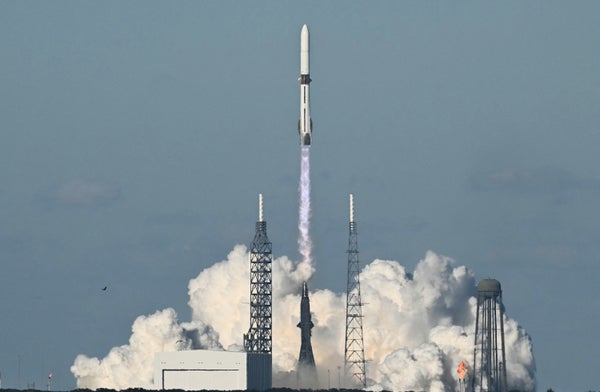November 13, 2025
2 min read
Blue Origin’s NASA Launch to Mars Is a Shot across the Bow for SpaceX
After delays, Jeff Bezos’ rocket company successfully launched a NASA mission to study Mars on Thursday.

CHANDAN KHANNA/AFP via Getty Images
Blue Origin successfully launched — and partially landed — the company’s New Glenn rocket Thursday, marking a major step forward in its bid to rival SpaceX as a reliable provider of reusable rockets for NASA and other government agencies.
The rocket took off from Cape Canaveral, Florida, at 3:55 P.M. EST loaded up with NASA’s ESCAPADE mission to study how space weather impacts Mars. Somewhat ironically, space weather was also the cause of the mission’s latest delays, as a severe solar storm on Wednesday made conditions in Earth orbit too risky to attempt a planned launch. The rocket’s reusable first stage, dubbed “Never Tell Me the Odds,” touched back down minutes later on a Blue Origin drone ship — a first for the company.
New Glenn’s flight represented a test for Blue Origin, which has long sought to compete with SpaceX’s fully reusable rockets, which dominate the global launch market. During New Glenn’s inaugural flight in January this year, the company failed to land the first stage on their oceanic barge. After today’s successful landing, Blue Origin is much better positioned to win lucrative launch contracts — including some that have recently been put back on the table for NASA’s upcoming moon missions that had originally gone to SpaceX.
On supporting science journalism
If you’re enjoying this article, consider supporting our award-winning journalism by subscribing. By purchasing a subscription you are helping to ensure the future of impactful stories about the discoveries and ideas shaping our world today.
Elon Musk’s rocket company is lagging behind on development for its Starship megarocket, which NASA had hoped to use to ferry astronauts to and from lunar orbit to the moon’s surface as part of the Artemis III mission slated for 2027. However, in October, Acting NASA Administrator Sean Duffy said the agency would reopen competition for the mission’s crewed lander — creating a potential opening for Blue Origin and other aerospace firms.
Days ahead of Thursday’s launch, Blue Origin CEO Dave Limp said that the company “would move heaven and Earth” to help NASA meet its goal of returning people to the moon as soon as possible.
It’s Time to Stand Up for Science
If you enjoyed this article, I’d like to ask for your support. Scientific American has served as an advocate for science and industry for 180 years, and right now may be the most critical moment in that two-century history.
I’ve been a Scientific American subscriber since I was 12 years old, and it helped shape the way I look at the world. SciAm always educates and delights me, and inspires a sense of awe for our vast, beautiful universe. I hope it does that for you, too.
If you subscribe to Scientific American, you help ensure that our coverage is centered on meaningful research and discovery; that we have the resources to report on the decisions that threaten labs across the U.S.; and that we support both budding and working scientists at a time when the value of science itself too often goes unrecognized.
In return, you get essential news, captivating podcasts, brilliant infographics, can’t-miss newsletters, must-watch videos, challenging games, and the science world’s best writing and reporting. You can even gift someone a subscription.
There has never been a more important time for us to stand up and show why science matters. I hope you’ll support us in that mission.



